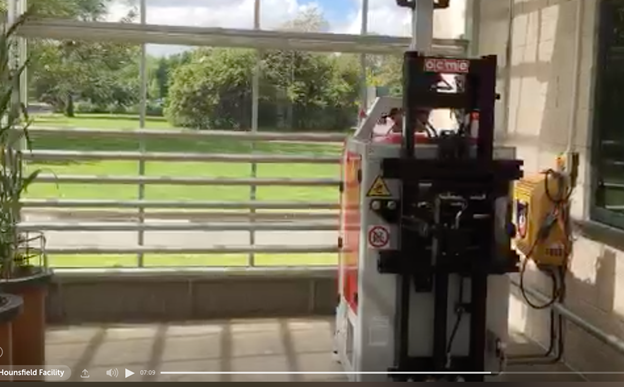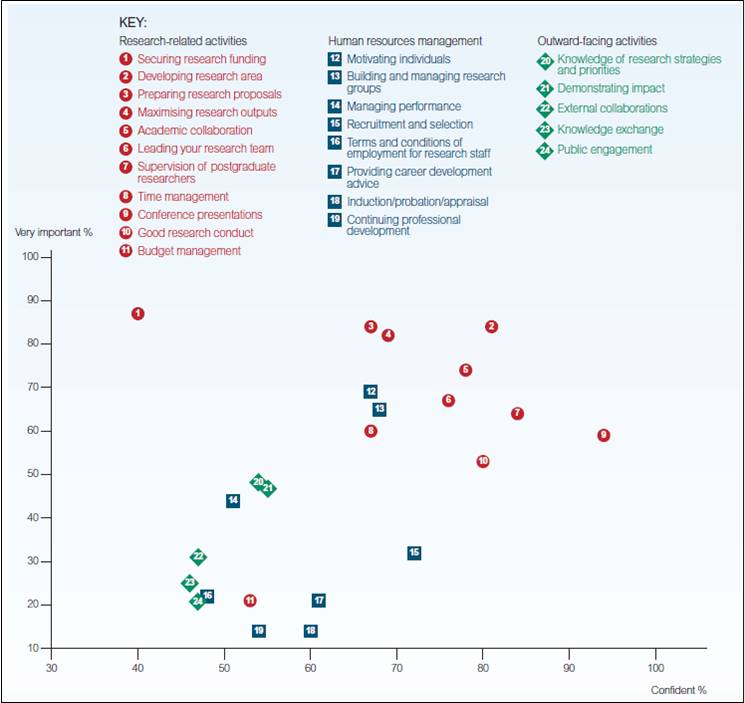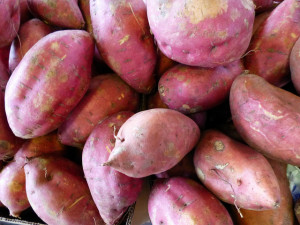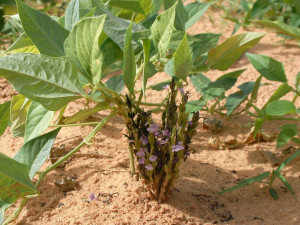


This week’s post was written by Dr Ian Street (@IHStreet), the Resources Editor at AoB Blog. He is also a science writer and plant scientist. His science blog is The Quiet Branches.
On 18th May 2017, plant scientists from all over the world celebrated “International Fascination of Plants Day”. This year, plant enthusiasts could follow events around the world – thanks to social media and live-streaming. Scientists shared live broadcasts about the science they do, the facilities where they work, models from history, about engaging students with plants, and more. Botany Live, organized by the AoB Blog, was an experiment in science engagement supported by the Society for Experimental Biology, The Annals of Botany Company, and Plantae. Overall, thousands tuned in to 31 planned events registered with Botany Live.
Using Periscope and Facebook Live, some reported from dedicated events planned around Plant Day. Others talked directly to the camera and their virtual audience about plants, plant science, and communicating plant science.
The Arabidopsis Biological Resource Center (ABRC) at Ohio State University showed off the facilities and robots they use to maintain both gene stocks and seed stocks. These facilities and resources, which provide essential support for plant research, are often only known within the plant science community. Even there, how they operate on a day-to-day basis remains a mystery to many. Botany Live allowed us to take a peek at the support structures that make international plant science possible. The ABRC videos also showed how plant science is using cutting edge technology with robots to automate seed sorting and gene stocks.

Frame from the Hounsfield Facility Botany Live Broadcast, showing the glass house and the robot that carries individual plants to be scanned.
A tour of the Hounsfield X-ray Facility (@UoNHounsfield) demonstrated the high-tech nature of modern plant science too. The staging the Hounsfield video was clever, as the scientists there clearly set up marks they had to hit to be on camera at certain times demonstrating the three sizes of scanner at the facility. Their live-stream ended with Malcolm Bennett in the glass house talking about the importance of exploring root traits, a big part of what they track at Hounsfield with robots and 3D X-ray tomography.
The National Institute of Agricultural Botany (NIAB) wheat transformation facility broadcast brought us cutting-edge biology directly from the field. Alison Bentley (@AlisonRBentley) guiding us around the facility, where scientists develop and field test new varieties of wheat, followed by a look around their glasshouses. Geraint Parry (@GARNetweets) then interviewed several NIAB conference attendees. A specialized facility for wheat transformation (making transgenic wheat) is, like the ABRC and Hounsfield, a resource of a special capacity to do something technical that not all individual labs can develop.

An infected plant in background and flower in the foreground from Monica Lewandowski’s Botany Live Broadcast.
Another outdoor tour of a garden in California was given by Monica Lewandowski. She highlighted the diversity of plants grown in the state’s central valley. She also spoke about some of the challenges that plants face, and why we need plant scientists to study them. It showed the simplicity possible with Periscope broadcasts, as her session focused on just her with planned talking points, a walking path, and her voice-over.
Alun Salt of the AoB Blog brought us some short broadcasts from Kew Gardens. He gave a brief tour of the Wollemi pine, an ancient lineage known only from fossils until 1994. He also gave a quick overview of the garden’s carnivorous plants, including the coolest plant in the world, Darlingtonia californica.
Several Botany Live recordings involved school students. Alistair Culham and Dr M (@drmgoeswild) broadcast a video with students about what they’d done earlier, counting plants and observing them. Many of the students were surprised to learn where pineapples come from: not from a tree, but a bush yielding a single pineapple a year. The Gramene Database (@GrameneDatabase) broadcast a talk with students about plants’ superpowers such as resurrection plants, which can lose 95% of their water and seemingly come back to life upon rehydration. Maria Papanatsiou (@m_papanatsiou) from the University of Glasgow broadcast Plant Day activities engaging students, and many of the videos can be found on the social wall of tweets made for Botany Live.
The most popular Plant Day broadcast was from the Manchester Museum, featuring botany curators Rachel Webster (Manchester) and Donna Young (Liverpool) talking about Brendel’s Plant Models collections from Manchester and the Liverpool World Museum. They’re remarkable models of plants, made of paper mache amongst other materials, created in 1880-1920 by a father/son team in Germany. They were designed to teach plant anatomy and many are incredibly intricate, with some even being able to be taken apart to show specific parts of a flower.

Brendel Plant Model Nr. 10, Pisum Sativum: Accreditation: By David Ludwig (own work at Botanical Museum in Greifswald) Image credit: CC BY-SA 3.0, via Wikimedia Commons.
Botany Live broadcasts came from all over the world, and the event can grow in the years to come. The format of live streaming is flexible, with elaborate or simple setups possible. Most broadcasts were under ten minutes, but some lasted almost an hour, and of course, they can be done nearly anytime and anywhere with a good data connection.
This first year of Botany Live was an experiment. With thousands of people reached (and likely more, as many of the videos are still available), it was a success and a boost to the Plant Day events already taking place, extending their reach online. Given the success the Manchester Museum had with their broadcast, more institutions being directly involved will help promote the live broadcasts and engage even more people in the fascinating world of plants.
Further reading:
GARNet newsletter also covered Botany Live in its May 2017 issue (pdf)
Celebrate Fascination of Plants Day (May 18th 2017) with an exciting new science communication project!
Botany Live is asking scientists, educators, science communicators and plant fans from around the world to live-stream their fascination with plants, sharing experiments, botanic garden explorations, tours of a lab or herbarium, Fascination of Plants Day events, interviews, discussions and more!
The aim is to spark an interest in new audiences, reaching people who might not otherwise engage with Fascination of Plants Day.
Get involved by emailing webmaster@aobblog.com for a link to a Google form where you can register your livestream session! The event will take place from the 18th-21st May.
Let’s make plants go viral!
This week’s post was originally published on The Conversation, and was written by Stuart Thompson, University of Westminster.
A new book, The Hidden Life of Trees, claims that trees talk to one another. But is this really the case? The simple answer is that plants certainly exchange information with one another and other organisms such as insects. Think of the scents of newly mowed grass or crushed sage. Some of the chemicals that make up these aromas will tell other plants to prepare for an attack or summon predatory insects to defend them. These evocative smells could be seen as cries of warning or screams for help.
When plants are damaged by infection or by being eaten, they release a range of volatile molecules into the air around them. After exposure to some of these chemicals, nearby plants of the same species and even other species become less vulnerable to attack, for example by producing toxins or substances that make themselves harder to digest. These changes don’t usually happen straight away but the genes needed turn on much more quickly when they are needed.
There is also evidence that the chemicals released by plants in a particular location are subtly different from those released elsewhere by the same species. Consequently, it seems that if plants talk, they even have languages or at least regional accents.
But is this really communication, as humans understand it? It really isn’t clear whether a plant releasing chemicals intends to pass on information to another plant by doing so. I respond to the chemicals released by frying onions but that doesn’t mean that the onions are talking to me. So are these really messages or just the opportunist use of chemical information in the environment?
It seems more likely that these signals started out not as a way to send information to other trees but to get messages quickly and efficiently to other parts of the same plant. Pests or infections will often jump from one branch of a tree to the ones closest to it. But a warning telling those branches to prepare for an imminent attack might have to travel most of the way through the tree and then back up it if the message had to move through the body of the plant. This could be a journey of tens of metres in a tall tree.
A signal that can travel through the air, meanwhile, can go directly to the branches closest to the attack. A consequence of these volatile signals, however, is that they can be “overheard” by any plants the chemicals reach. So when other trees respond by also beefing up their defences, is it communication or eavesdropping?
Perhaps it is a bit of both. Maybe an internal messaging system became co-opted to help plants close enough to “listen in” as they would often be related to the tree sending the message in a classic example of evolutionary “kin selection”. However, releasing chemicals into the environment is indiscriminate and other plants and organisms can take advantage. Sometimes these chemical “messages” can attract pests or parasites. The smell of crushed sage doesn’t protect it from humans, for example … rather the opposite.
Not all transfer of information between plants is through the air. The vast majority of plants live in symbiotic relationships with soil fungi. We tend to think of forest fungi as mushrooms and toadstools above the ground but these only pop up after sexual reproduction. The real fungus is a mat of elongated cells spreading through the forest floor.

The trees provide the fungi with sugar and the fungi help the tree to gather water and soil nutrients. And many plants can be joined underground by cells of the same individual fungus. Sometimes when one plant suffers damage, other plants connected to it through their soil fungi protect themselves against future attacks while other plants equally near that aren’t “plugged in” don’t. This fungal network is another carrier for information, a true Wood Wide Web.
But who is in control? The messages are relayed by the fungus and perhaps it is the one really using the information, gathering it from one of its host plants and passing it on to the others to protect its “revenue”. The fungus helps the plants to communicate but may do it for its own purposes, and that might include preferentially helping its best producers, whether they are related to the tree sending the message or not. Information intended for family and friends may end up being passed on to unrelated third parties to profit the carrier of the message. In this way, fungi is a bit like a social media company, listening into and benefiting from its users’ posts.
So we return to the question of whether any of these examples are communication in the sense that we would mean it. Anything that makes people think more about plants is good, but perhaps making trees seem more like us can lead us to overlook their essential nature. As a slightly hippy student, what attracted me to plant science was the way that trees and other plants fluidly adjust to their environment. Perhaps using the chemicals that reach them to shape their adaptation is just another facet of this. Worrying about whether trees communicate actually says more about us than them.
![]()
Stuart Thompson, Senior Lecturer in Plant Biochemistry, University of Westminster
This article was originally published on The Conversation. Read the original article.
This week’s blog post is written by Sarah Blackford.
Plant scientists are generally very good at growing their plants, taking good care of them and making sure they’re well fed and watered. But what about their own development? Who’s growing them?
In a recent survey, Principal Investigators (PIs) were asked to rate areas of their work they perceived to be the most important. Research-related activities were valued the highest (Vitae, 2011), while conversely, “providing career development advice” and “continuing professional development” were rated as two of their lowest priorities, at around 5% (see figure). This, perhaps, is not surprising when you consider PIs need to prioritize a multitude of responsibilities on their ‘to do’ list.

Figure reproduced from Principal investigators and research leaders survey, Vitae (2011) showing the importance of activities and functions for the development of research leaders, against their own confidence in those activities
Like the plant, overlooking the growth of the person could lead to plant scientists being held back from a flourishing career. So, taking responsibility for your own development is vital, especially since programs of professional and personal development are not always readily available to PhD students and researchers in many institutes and universities. Even if they are, the content and timing is not always relevant or convenient. I’ve been delivering bespoke career development workshops for bioscientists, including plant scientists, for over 10 years now and one of the main aims is to help people to help themselves. As well as providing practical information and advice on bioscience-related careers, job seeking strategies and career transition planning, I use interactive exercises and discussions to raise self-awareness. This involves recognizing the range of skills acquired through research, appreciating work values, linking interests with career choice and showing how personality plays a crucial role in effective communication and leadership. During the workshops, the participants complete a personal action plan identifying what they need to do to grow their own careers.
Most people need to update and improve their CVs (even me!), hone their interview technique and perfect their self-presentation skills. But personal and professional development requires a range of different actions depending on career goals and intentions. Some PhD students want to continue on to do at least one postdoc and then decide whether to carry on after that. With quite a good number of posts available, and with some industry recruiters saying they prefer researchers with postdoc experience, this can be an excellent first step – but be careful to ensure you’re moving forward and building on your experience. Look at the career stories of early career researchers who were awarded this year’s prestigious SEB president’s medal – they relate strategies they have used to fill gaps in their expertise and to position themselves favorably to secure a permanent research leadership position. For researchers who are aspiring academics, their plans may include actions such as submitting an abstract to give a talk at a forthcoming conference, doing some strategic networking or finding a mentor to help them to apply for a fellowship.
For those considering a non-academic career, their personal development will depend on which career sector they plan to move into. For example, arranging work shadowing or doing voluntary work can help shift your career towards your desired destination. I helped out at the career service during my job as assistant editor when I was based at Southampton University, giving me enough experience and a reference to break into this career. Internships can provide opportunities to spend time working in areas such as policy, outreach and publishing, and if you’re a budding science writer you can simply start up your own blog, or write on someone else’s – like this one! Everyone would benefit from setting up or improving their presence on social media, whether it’s Researchgate, LinkedIn or Twitter. These global networks help to raise your profile, provide information about companies and careers of interest, build relationships and even advertise jobs. Generic training in communication, networking, self-awareness and other personal effectiveness can help to improve everyone’s self-reliance and confidence.
So in answer to the question, “how do you grow a plant scientist?” I would say it depends on their field of interest and direction of growth. Never think of your PhD as the end of your learning – it’s another new beginning. Even PIs lack confidence in some important aspects of their work, such as securing research funding (see figure) and would likely benefit from training in this area, not to mention management and leadership. Growing plants is your business; without them you would make no progress, nor generate results on which to write your publications and build a career. Ignore your own personal growth and you might be in danger of going to seed!
This blog is a summary of the career workshop, organized and delivered by Sarah Blackford, at the recent FESPB/EPSO Congress 2016 in Prague.
Sarah Blackford started her career in plant science research at York University, moved into journal publishing with the Journal of Experimental Botany and then trained to be a professional higher education careers adviser. She is currently the Head of Education and Public Affairs at the Society for Experimental Biology (SEB) and writes a regular blog for bioscience PhD students and postdocs: www.biosciencecareers.org
So you’re hearing good things about the new plant science networking platform Plantae and want to get involved? You’ve come to the right blog post! Read on to learn how to set up your profile, find friends and get involved with the community.
Plantae is a great place to network with researchers around the world, so you’ll want your profile to be as detailed as possible.
As a minimum, add your name, a profile photo, your professional affiliations and a summary of who you are and what you do. This will help your colleagues and friends to find you, and break the networking ice with new connections!
What makes a good bio? Give the reader a little information about your fields of interest, background, plant science outreach, new papers, favorite plant, whatever you like (related to plants and plant science, of course!). Remember that Plantae is a professional networking site, so don’t put anything on there that you wouldn’t want your boss (current or future!) to see!
A great feature of the Core Profile is the ability to add your social media profiles, website, and enhance the visibility of your research by adding researcher profiles, for example your ORCID, Mendeley, or ResearchGate account. To ensure that the accounts connect properly, add the full URL of each profile, not just your account name.
From the Community homepage you can choose to see the recent activity of your friends, but only if you’ve added them first!
To find colleagues, click on ‘Members’ and you can search for a name, or filter all members by city, state or country. Click on your friend’s name to go to their profile. On the left sidebar, you’ll see a button named ‘User Actions’, which when clicked brings up the option to add them as a friend. After they accept your request, you’re officially friends. Congratulations!
Now you’ve added everyone you know, it’s time to connect with people that you don’t! Get over to the Discussion boards and let everyone know how you feel about the latest hot paper or public engagement scheme. Or you could join a Group of users who share your interests, location, or love of plant-themed poetry (disclaimer: the latter is currently not a Plantae group – feel free to start it!). It’s easy to join conversations or start one of your own.
Plantae is a hub of plant science resources, including research news, funding opportunities, job advertisements, science policy news and a wealth of education and public engagement tools. Log in regularly to see up and coming events, grant calls, opinion pieces and more, or maybe upload some of your own!
There you have it. Now you know the basics, reach out to the Plantae network, get involved in exciting plant science discussions, make the most of funding and job opportunities, and, pretty please, fill in your profile!
 This week we bring you something a little different!
This week we bring you something a little different!
Four eighth grade students from The Nueva School in Hillsborough, California are releasing “They Grow”, a scienceified version of the popular Drake song “Headlines” (warning: Headlines contains explicit language!). In the video the students rap about photosynthesis, starting with the basics and moving on to the intricate processes of the light reaction and the Calvin cycle.
With help from their science teacher, Tom McFadden, these four students wrote and performed their lyrics, then planned, shot and edited their music video. Tom’s “Science Rap Academy” class meets twice a week for an hour each Tuesday and Thursday. The students have been working on this project since January and are very excited to finally release it to the world. They hope that their video will help students better understand the complex process known as photosynthesis.
Watch the video:
“I think that this song and video that we have created will help provide students learning about photosynthesis with a fun, engaging and relatable way to learn how plants grow,” – Alex, coproducer and rapper.
“This song brings energy into the classroom while effectively communicating the perplexing process of photosynthesis. I think that this song will be engaging and entertaining, and was a blast to film,” – Stanley, coproducer and rapper.
“Our number one goal with this song was to make learning about science, specifically photosynthesis, fun to learn. I think that we were able to achieve that by scienceifing a popular song that many kids know, so they can really connect to it. We also made the video and song easy to follow and understand so people of all ages can learn from it,” – Jason, coproducer and filmmaker.

“This entire process was very fun, writing and singing our lyrics and filming the video. I’m really thrilled to share this final product that we have been working hard on to the world and I hope that people enjoy it,” – Quincy, coproducer and rapper.

Last April I joined the Global Plant Council as a New Media Fellow along with Sarah Jose from the University of Bristol. The GPC is a small organization with a big remit: to bring together stakeholders in the plant and crop sciences from around the world! As New Media Fellows, Sarah and I have have assisted in raising the online profile of the GPC through various social media platforms. We wrote about our experiences in growing this blog and the GPC Twitter and Facebook accounts in the The Global Plant Council Guide to Social Media, which details our successes and difficulties in creating a more established online presence.
Why do it?

My wheat growing in Norfolk field trials. I have spent every summer for the past 3 years out here analysing photosynthesis and other possible contributors to crop yield
I chose to apply for the fellowship during the third year of my PhD. Around this time I had started to consider that perhaps a job in research wasn’t for me. It was therefore important to gain experience outside of my daily life in the lab and field, explore possible careers outside of academia and of course to add vital lines to my CV. I still loved science, and found my work interesting, so knew I wanted to stay close to the scientific community. Furthermore, I had always enjoyed being active on Twitter, and following scientific blogs, so the GPC fellowship sounded like the perfect opportunity!
The experience
I think I can speak for both Sarah and myself when I say that this fellowship has been one of the best things I’ve done during my PhD. Managing this blog for a year has allowed me to speak to researchers working on diverse aspects of the plant sciences from around the world. My speed and writing efficiency have improved no end, and I can now write a decent 1000 word post in under an hour! I discovered the best places to find freely available photos, and best way to present a WordPress article. Assisting with Twitter gave me an excuse to spend hours reading interesting articles on the web – basically paid procrastination – and I got to use my creativity to come up with new ways of engaging our community.
Of course going to Brazil for the Stress Resilience Symposium, GPC AGM and IPMB was a highlight of my year. I got to present to the international community both about my own PhD research and the work of the GPC, Sarah and I became expert camera women while making the Stress Resilience videos, and I saw the backstage workings of a conference giving out Plantae badges on the ASPB stand at IPMB. It didn’t hurt that I got to see Iguassu Falls, drink more than a few caipirinhas and spend a sneaky week in Rio de Janeiro!
Thank you
Working with the GPC team has been fantastic. I learnt a lot about how scientific societies are run and the work they do by talking to the representatives from member societies at the AGM. The executive board have been highly supportive of our activities throughout. Last but not least, the lovely GPC ladies, Ruth, Lisa and Sarah have been an amazing team to work with – I cannot thank you enough!
I have now handed in my PhD, left the GPC, and moved on to a new career outside of academic research. I’m going into a job focused on public engagement and widening access to higher education, and have no doubt my GPC experiences have helped me get there. My advice if you’re unsure about where you want to end up after your PhD? Say “yes” to all new opportunities as you never know where they will take you.
Thank you the GPC! Hopefully I’ll be back one day!
Throughout my PhD, I often found myself explaining why plants are fascinating, justifying why I was devoting four years of my life to researching the minute details of their biology.
A few weeks ago, I thought I’d ask the #plantsci community on Twitter what makes them love plants. The response was phenomenal, so I thought I’d share it here as a fun way to transition to 2017!
(This is just a handful of the huge number of comments. To read them all, click here.)
Hey #plantsci, I need your help! What makes you love plants? What’s your comeback to “plants are boring”? Thanks! Plz RT! @PlantTeaching 😉
— Sarah Jose (@JoseSci) November 9, 2016
Many of us are amazed by the fact that they can fend for themselves, rather than running away from harsh conditions or predators:
@JoseSci @PlantTeaching Plants have to deal with many of the same struggles as animals – and they can’t even run away. — Alice Foxall (@alicefoxall) November 13, 2016
@JoseSci @PlantTeaching They’re incredibly resilient and adaptive all without having a nervous system or being able to move!
— Silvia Caldararu (@SCaldararu) November 10, 2016
@JoseSci @DJPMoore Plants survive and thrive in places most humans would never dare even to visit. — Tom Buckley (@TomBuckleyLab) November 10, 2016
@JoseSci forever plastic and survive in the situation wherever they lay their roots. Not denying that’s cool!
— Kelly (@kaatkins7) November 10, 2016
Don’t worry though, because plants can fight back:
@JoseSci @PlantTeaching my tree was attacked by aphids. It released a sweet liquid that attracted ants, chasing away the aphids! — Allen Greeley (@taku2473allen) November 9, 2016
They can alter their environments in really interesting ways too:
@JoseSci @SCIHorticulture @PlantTeaching exudates – active modification of rhizosphere to block toxins entering roots and mobilise nutrients
— Mark Nason (@Cornwall_SciEnv) November 9, 2016
A lot of people are interested in plant reproduction:
@JoseSci @PlantTeaching #Plant sex lives (reproductive life cycles) are so much more complex than ours. Animal life cycles are boring. — Eve Emshwiller (@EveEmshwiller) November 10, 2016
@JoseSci @Botanical_ @PlantTeaching look at all of those reproductive strategies. Plants are truly amazing!
— The Morris Lab @MTSU (@themorrislab) November 9, 2016
Some species can survive for millennia:
@JoseSci @PlantTeaching even relatively short lived yes love longer than humans… some trees count in centuries — Dave Moore (@DJPMoore) November 9, 2016
@JoseSci @PlantTeaching Try cutting one of your appendages off and see if it regrowth like a plant can.
— Edith L. Hardcastle (@elhardcast) November 9, 2016
@JoseSci @PlantTeaching some genetic individuals (plants) might live forever — Dave Moore (@DJPMoore) November 9, 2016
Much of the rest of the ecosystem relies on them…
@JoseSci @DJPMoore Plants can live without us, but we can’t live without them. Animals are just parasites on a biosphere fueled by plants.
— Tom Buckley (@TomBuckleyLab) November 10, 2016
@JoseSci @PlantTeaching if animals died out many plants would survive…if plants died out most animals would die also — Dave Moore (@DJPMoore) November 9, 2016
… and of course, they give us much of what we need to survive…
@JoseSci @PlantTeaching bread, beer, wine, oxygen…
— Matthew Gilliham (@IonPlants) November 10, 2016
@MMLewandowski52 @PlantTeaching @JoseSci literally food out of (thin) air…especially in aeroponic systems — Krishna Udaiwal (@Plant_Learner) November 10, 2016
@JoseSci @PlantTeaching Plants do everything we do + capture sun E + synthesize virtually all useful medicines and poisons + are beautiful
— Paul Twigg (@UNKBiol106) November 9, 2016
@JoseSci @PlantTeaching Kinda hard to breathe without ’em, for one! — Dan Lin (@DLinYZ) November 10, 2016
@JoseSci @PlantTeaching Well, they make colours, flavours, fragrances, drugs…
— Anne Osbourn (@AnneOsbourn1) November 10, 2016
@JoseSci @PlantTeaching we depend on plants for just about everything, plants are _not_ boring! — McPanos (@panagopucakes) November 18, 2016
We need to highlight how amazing plants are, to counteract “plant blindness”:
@JoseSci @PlantTeaching read this amazing article about #plantblindness by @fossilplants https://t.co/xYWS0MATGM — Lyza Maron (@LyzaMaron) November 10, 2016
@JoseSci @Botanical_ @PlantTeaching plants are all around, always. We watch them seldom. The beauty of the unseen — SEB (@SEBriologia) November 9, 2016
Plant blindness means that many people are unaware of the amazing things that are happening around them:
@JoseSci @PlantTeaching 1) only boring on a minute-by-minute timescale – sped-up timelapses reveal remarkable behaviour (eg phototropism) — Daniel Seaton (@DanielDSeaton) November 11, 2016
@JoseSci @PlantTeaching plants are more just more veiled about how cool they are…like the quiet kid w/ some WILD tricks up their sleeve
— Beth Ansaldi (@AWomaninSTEM) November 9, 2016
Being scientists, a lot of people liked how easy plants are to work with!
@JoseSci @PlantTeaching Plants stay in one place, so I can sample them easily. I love them for that! — A.C. Papageorgiou (@ACPapageorgiou) November 10, 2016
@JoseSci @PlantTeaching It is not as much paperwork when you want to dissects plants! And their stem cells make Sequoia trees live (almost) forever ! — Marie Pireyre (@MapiMry) November 10, 2016
@JoseSci @PlantTeaching They stand still while I measure them! — Vigdis Vandvik (@VVandvik) November 10, 2016
Some of the biggest scientific discoveries were made in plants:
@JoseSci @PlantTeaching the big discoveries. Mendel & the pea; Hook & first cell; McClintock & transposable elements; PTGS in petunia
— Peter Etchells (@peter_etchells) November 9, 2016
In conclusion:
.@JoseSci @JohnInnesCentre @PlantTeaching
Plants are awesome!
— Molecular Plant Path (@MPPjournal) November 11, 2016
Thanks to everyone who took part in this twitter chat! This is just a subset of the huge number of comments we received. To read them all, click here!
Have we missed anything? Why do you love plants?
With another year nearly over we recently put out a call for nominations for the Most Influential Plant Science Research of 2015. Suggestions flooded in, and we also trawled through our social media feeds to see which stories inspired the most discussion and engagement. It was fantastic to read about so much amazing research from around the world. Below are our top five, selected based on impact for the plant science research community, engagement on social media, and importance for both policy and potential end product/application.
Choosing the most inspiring stories was not an easy job. If you think we’ve missed something, please let us know in the comments below, or via Twitter! In the coming weeks we’ll be posting a 2015 Plant Science Round Up, which will include other exciting research that didn’t quite make the top five, so watch this space!

Sweet potato contains genes from bacteria making it a naturally occurring GM crop. Image from Mike Licht used under creative commons license 2.0
Scientists at the International Potato Center in Lima, Peru, found that 291 varieties of sweet potato actually contain bacterial genes. This technically means that sweet potato is a naturally occurring genetically modified crop! Alongside all the general discussion about GM regulations, particularly in parts of Europe where regulations about growing GM crops have been decentralized from Brussels to individual EU Member States, this story caused much discussion on social media when it was published in March of this year.
It is thought that ancestors of the modern sweet potato were genetically modified by bacteria in the soil some 8000 years ago. Scientists hypothesize that it was this modification that made consumption and domestication of the crop possible. Unlike the potato, sweet potato is not a tuber but a mere root. The bacteria genes are thought to be responsible for root swelling, giving it the fleshy appearance we recognize today.
This story is incredibly important, firstly because sweet potato is the world’s seventh most important food crop, so knowledge of its genetics and development are essential for future food supply. Secondly, Agrobacterium is frequently used by scientists to artificially genetically modify plants. Evidence that this process occurs in nature opens up the conversation about GM, the methods used in this technology, and the safety of these products for human consumption.
Read the original paper in PNAS here.
Our number two on the list also relates to genetic modification, this time focusing on methods. Regardless of whether or not we want to have genetically modified crops in our food supply, GM is a valuable tool used by researchers to advance knowledge of gene function at the genetic and phenotypic level. Therefore, systems of modification that make the process faster, cheaper, and more accurate provide fantastic opportunities for the plant science community to progress its understanding.
The Cas9 system is a method of genome editing that can make precise changes at specific locations in the genome relatively cheaply. This novel system uses small non-coding RNA to direct Cas9 nuclease to the DNA target site. This type of RNA is small and easy to program, providing a flexible and easily accessible system for genome editing.

Barley in the field. Image by Moldova_field used under creative commons license 2.0
Inheritance of genome modifications using Cas9 has previously been shown in the model plants, Arabidopsis and rice. However, the efficiency of this inheritance, and therefore potential application in crop plants has been questionable.
The breakthrough study published in November by researchers at The Sainsbury Laboratory and John Innes Centre both in Norwich, UK, demonstrated the mutation of two commercial crop plants, Barley and Brassica oleracea, using the Cas9 system and subsequent inheritance mutations.
This is an incredibly exciting development in the plant sciences and opens up many options in the future in terms of genome editing and plant science research.
Read the full paper in Genome Biology here.
Striga is a parasitic plant that mainly affects parts of Africa. It is a major threat to food crops such as rice and corn, leading to yield losses worth over 10 billion US dollars, and affecting over 100 million people.
Striga infects the host crop plant through its roots, depriving them of their nutrients and water. The plant hormone strigolactone, which is released by host plants, is known to induce Striga germination when host plants are nearby.
In a study published in August of this year the Striga receptors for this hormone, and the proteins responsible for striga germination were identified.
Striga plants are known to wither and die if they cannot find a host plant upon germination. Induction of early germination using synthetic hormones could therefore remove Striga populations before crops are planted. This work is vital in terms of regulating Striga populations in areas where they are hugely damaging to crop plants and people’s livelihoods.
Read the full study in Science here.

Striga, a parasitic plant. Also known as Witchweed. Image from the International Institute of Tropical Agriculture used under creative commons license 2.0
Resurrection plants are a unique group of flora that can survive extreme water shortages for months or even years. There are more than 130 varieties in the world, and many researchers believe that unlocking the genetic codes of drought-tolerant plants could help farmers working in increasingly hot and dry conditions.
During a drought, the plant acts like a seed, becoming so dry that it appears dead. But as soon as the rains come, the shriveled plant bursts ‘back to life’, turning green and robust in just a few hours.
In November, researchers from the Donald Danforth Plant Science Centre in Missouri, US, published the complete draft genome of Oropetium thomaeum, a resurrection grass species.
O. thomaeum is a small C4 grass species found in Africa and India. It is closely related to major food feed and bioenergy crops. Therefore this work represents a significant step in terms of understanding novel drought tolerance mechanisms that could be used in agriculture.
Read the full paper in Nature here.
Currently, one of the greatest challenges for ecologists is to quantify plant diversity and understand how this affects plant survival. For the last 500 years independent research groups around the world have collected this diversity data, which has made organization and collaboration difficult in the past.
Over the last 500 years, independent research groups have collected a wealth of diversity data. The Botanical Information and Ecology Network (BIEN) are collecting and collating these data together for the Americas using high performance computing (HPC) and data resources, via the iPlant Collaborative and the Texas Advanced Computing Center (TACC). This will allow researchers to draw on data right from the earliest plant collections up to the modern day to understand plant diversity.
There are approximately 120,000 plant species in North and South America, but mapping and determining the hotspots of species richness requires computationally intensive geographic range estimates. With supercomputing the BIEN group could generate and store geographic range estimates for plant species in the Americas.
It also gives ecologists the ability to document continental scale patterns of species diversity, which show where any species of plant might be found. These novel maps could prove a fantastic resource for ecologists working on diversity and conservation.
Read more about this story on the TACC website, here.